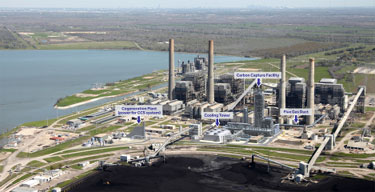NRG Energy, one of the largest utilities in the US, announced it will cut carbon emissions 50% by 2030 and 90% by 2050, charting a course for others in the industry to follow.
"Having already reduced our carbon emissions by 40% since 2005, we see a clear path to further dramatic long-term reduction as we vigorously pursue our multi-faceted, long term sustainable growth strategy," says David Crane, CEO. "As the U.S. transitions to a renewables-driven, increasingly distributed, grid resilient energy system, we expect to be a leader both in clean energy and in converting the carbon emissions of our conventional generation from a liability to a profitable by-product."
That means, NRG will keep running some of its coal plants, but will capture the carbon and either sell it or sequester it, as they are doing for the first time in Texas at the Petra Nova Carbon Capture Project – one of the five most polluting power plants in the US:

While most of its peers are pushing back against the growth of renewable energy, NRG embraces it. From its leadership on solar and wind through its YieldCo, NRG Yield, to electric car charging stations and carbon capture, the company sees distributed energy as a route to growth. They are even innovating on mobile solar, grid-integrated vehicles, and are challenging the biggest players in California’s rooftop solar market.
The company also announced it has outgrown its headquarters, giving it an opportunity to design a new cutting-edge building that "characterizes the NRG vision." The three-floor, 130,000 square foot building in Princeton, New Jersey will be a "showcase for one of the most trailblazing resource-efficient, grid-resilient designs achievable by corporate America today," they say. It opens in 2016.
- Off-grid capabilities through dual-fuel generators and combined heat and power (CHP) systems for heating and cooling;
- combination of LED lighting and daylighting to keep energy use 30% lower than conventional buildings;
- 12,000 gallons of rainwater harvesting capacity to reduce water use 80%;
- 30 electric vehicle charging stations with EV-to-grid (eV2g) back-feed capability;
- two on-site solar fields totaling 765 kilowatts;
- if energy from the grid is used, it will be 100% renewable through one of NRG’s green retail subsidiaries.
"The power industry is the biggest part of the problem of greenhouse gas emissions, but it has the potential to be an even bigger part of the solution," David Crane told the NY Times.
"We got sick of waiting around to see what was going to happen on the policy end," Leah Seligmann, Chief Sustainability Officer for NRG, told ThinkProgress. "Frankly if the industry doesn’t follow us and start moving, people aren’t going to have much patience with it. We can either become extinct or we can become involved."
Barclay’s recently downgrade of the utility industry due to failing to address long-term challenges from the growth of solar, shows clinging to the past doesn’t help.
Indeed, the industry would be hailed if it proactively moved forward, instead of forcing the EPA to regulate its emissions … and then fighting it tooth and nail. As the major source of carbon emissions in the US, it could play a major role in preventing global temperature rise beyond 2 degrees C – no small accomplishment.
"Leading corporations recognize it’s no longer enough to talk about carbon reductions. Rather companies must take the lead and bring their technologies, capabilities, and human capital to bear on humanity’s most pressing problem – climate change," says Mauricio Gutierrez, COO of NRG Energy in a blog.
